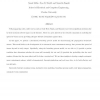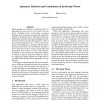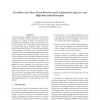216 search results - page 1 / 44 » Modeling and Automated Containment of Worms |
DSN
2005
IEEE
15 years 6 months ago
2005
IEEE
Self-propagating codes, called worms, such as Code Red, Nimda, and Slammer, have drawn significant attention due to their enormous adverse impact on the Internet. There is a grea...
BROADNETS
2007
IEEE
15 years 6 months ago
2007
IEEE
Abstract— Encounter-based network is a frequentlydisconnected wireless ad-hoc network requiring immediate neighbors to store and forward aggregated data for information dissemina...
95
Voted
USENIX
2008
15 years 2 months ago
2008
Recent popularity of interactive AJAX-based Web 2.0 applications has given rise to a new breed of security threats: JavaScript worms. In this paper we propose Spectator, the first...
117
Voted
INFOCOM
2003
IEEE
15 years 5 months ago
2003
IEEE
— It has been clear since 1988 that self-propagating code can quickly spread across a network by exploiting homogeneous security vulnerabilities. However, the last few years have...
88
Voted
CN
2007
15 years 12 days ago
2007
As next-generation computer worms may spread within minutes to millions of hosts, protection via human intervention is no longer an option. We discuss the implementation of SweetB...



